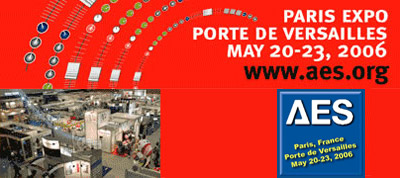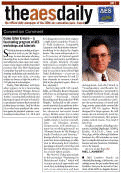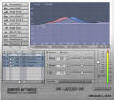
"Convention Comment..."
Mel Lambert's special reports for "The AES Daily"
AES Daily Day 1/Saturday May 20 Edition: A fascinating program of AES workshops and tutorials
 Selecting sharp recording and production tools is just the beginning. As soon becomes obvious, knowing how to use them creatively and effectively takes time and experience. Gear junkies will be heartened to know that The AES Organizing Committee has laid on a series of fascinating workshops and tutorials during the next four days, covering subject as diverse a high-bit audio to 3-D playback technologies.
Selecting sharp recording and production tools is just the beginning. As soon becomes obvious, knowing how to use them creatively and effectively takes time and experience. Gear junkies will be heartened to know that The AES Organizing Committee has laid on a series of fascinating workshops and tutorials during the next four days, covering subject as diverse a high-bit audio to 3-D playback technologies.
Today, Vicki Melchior will chair what appears to be a fascinating workshop entitled "Design, Process and Function in High Resolution Audio," covering both technical and theoretical aspect of what to look for in production systems that extend the performance envelope. And for those of us who have pondered the numbers game for playback systems - ever wondered where these 5.1, 10.2 and X.Y designations have their origins? - might want to catch the "From 5.1 To Field Synthesis: Compatible Captation and Restitution Systems" workshop to be chaired by Angelo Farina. The event will provide an A-to-Z overview of classical spatial recording and replay possibilities, from simple binaural through Ambisonics to complex but highly realistic wavefront reconstruction. And we can learn more about High Order Ambisonics - a new one on me! - that uses between 16 and 25 data channels to recreate a soundfield in the playback space. More is less, anybody?
And staying with 3-D soundfields, on Monday Kimio Hamasaki will chair an intriguing workshop entitled "Surround Sound Recording and Reproduction With Height," dedicated to the controversial premise that up/down information is one of the essential issues for advanced surround sound arrays. Makes sense, but at what cost in complexity and data bandwidth; check it out for yourself! Also on Monday, Jeremy Cooperstock will moderate a must-see workshop/tutorial on "Human Factors In The Design of Audio Products and Systems," during which he promises to separate fact from mythology, in addition to discussing how interface paradigms should extend beyond the familiar GUI. Bring your ideas for a lively Q&A session.
My Vote for Today goes jointly to this morning's "Mastering for Multichannel Audio," which will examine practical approaches and work flow, including dynamics control, stereo downmix and bass management, and after lunch to "Loudspeakers and Rooms for Sound Reproduction," presented by the affable Dr. Floyd Toole, during which he promises to contrast the ways in which acousticians evaluate the performance of small and large rooms, particularly around the critical 300 Hz region. Rules designed for large spaces, he will stress, do not necessarily work for smaller environments, like project studio control rooms. You heard it here first.
Finally, a number of leading companies, including Digidesign, ADAM, Studer, DAVID, Saati and VoiceAge, will be offering Exhibitor Seminars for AES attendees to come hear in-depth discussions of system feature and user functions. Definitely not to be missed. See you on the floor!
AES Daily Day 2/Sunday May 21 Edition: The Big Iron - still a critical role for medium- and large-format consoles
 A Luddite I am not. So is this heresy to suggest that, despite all we can do within the box using a DAW Engine, the demise of digital and analog consoles might be a shade premature? Not in the least. Don't get me wrong; 1,000+ Digidesign ICON users cannot be wrong (stand 1209), but it's not a solution for everybody.
A Luddite I am not. So is this heresy to suggest that, despite all we can do within the box using a DAW Engine, the demise of digital and analog consoles might be a shade premature? Not in the least. Don't get me wrong; 1,000+ Digidesign ICON users cannot be wrong (stand 1209), but it's not a solution for everybody.
There are a number of instances for which the use of a dedicated DSP Core connected to a fully assignable control surface makes a lot of sense. Consider, for example, a production facility where the various environments need to offer enhanced flexibility, either because the type of projects vary dramatically during different times of the day, or because the local community requires not only music recording but scoring, mix-to-picture and related functions. Despite their dazzling capabilities, DAWs cannot handle certain types of productions - the number of fully-featured signal paths might be lower that you'd expect - and their control surfaces, however elegantly laid out, might not be everybody's cup of tea.
Console manufacturers have not been unaware of the marketing messages from DAW manufacturers. For example, several offerings innovated in the past half year not only embrace HUI and Mackie Universal protocols for controlling DAW plug ins, but also offer a plug in-based look-and-feel for system setup, processing and routing functions accessible within the connected DSP engine. And if the console developer really understands how to properly implement MIDI control - unfortunately, not all do - then simultaneous control of an external DAW while commanding some light-speed computations within the proprietary core offers a flexible combination of mixing inside the box linked to powerful layering, multichannel processing and stem-based assignments from the dedicated core.
Add a fully implemented monitor section with all the soloing, metering and PEC/DIR switching we are beginning to realize separates the true professional from the wannabe, not to mention an automation system that can handle all of the mix merge and non-real time write/read capabilities needed to speed up a typical session, and we start to appreciate the value of extra functionality that further complicates the buying decision.

 In the past, there was always a trade off between what we'd like to see in a medium/large-format console and what we could afford. That Cost:Performance ratio is on the move, I predict, with at least two offerings here at the Paris Convention from established brands at a price point that will raise an eyebrow.
In the past, there was always a trade off between what we'd like to see in a medium/large-format console and what we could afford. That Cost:Performance ratio is on the move, I predict, with at least two offerings here at the Paris Convention from established brands at a price point that will raise an eyebrow.
Check out the new Studer VISTA 5 (pictured left) and the Soundcraft Vi6 (pictured right) (stand 1701) as examples of tightly optimized hardware that might be a viable alternative to a DAW controller for specific applications. While I would be the first to concede that two consoles - with a common ancestry, come to that - might not constitute a trend, there is no denying that there is life left in the genus. Other examples are being offered by Soundtracs (stand 1211), AMS Neve/SAE (stand 1420), Lawo (stand 1905), Stagetec (stand 2014), Euphonix (stand 1905), Calrec (stand 1318) and Fairlight (stand 1214).
AES Daily Day 3+4/Mon+Tue May 22/23 Edition: Let's hear it for the Dealers - and "bitchin'" Roger Nichols
 For this, my last report from the Paris AES Convention, I want to throw the spotlight onto a trio of French distributors worthy of your attention, look at a new spatialization development, plus a range of customized plug ins with strange sounding names.
For this, my last report from the Paris AES Convention, I want to throw the spotlight onto a trio of French distributors worthy of your attention, look at a new spatialization development, plus a range of customized plug ins with strange sounding names.
Audio Addict (stand 1929) was founded a year ago by Christopher Bouillot, who saw the writing on the wall for the studio business and made a change of direction. "I look for unique, one-of-a-kind alternate products," he explains. Based in Chevilly-Larue, just south of Paris, Bouillot's high-end line includes Flea mics, Crowley & Tripp ribbon mics, Enhance Audio M600 mic mounts plus exotic outboards from Little Labs and Alternate Sounding. "The AES Convention has worked out very well for me; there has been a lot of interest from customers."
Tapages & Nocturnes (stand 1016), based in Paris, specializes in sales and rental of TV and film location-sound products, and was founded 23 years ago by three audio engineers who pooled their equipment. Today, the company is number one in it field. "We specialize in rental of 4/8-track DAW systems, including Pro Tools, which are becoming very popular with our customers," says president/general director Olivier Binet. Recent productions include "Brice de Nice" and director Luc Besson's "Angela," as well as a range of reality TV shows and "Kholanta," a French-based "Survivor"-type show. Not to be missed: Holophone surround sound mics used successfully on the Grammy Awards and a number of US sporting events.
UM Distribution (stand 1835) was founded eight years ago at a Paris-based store that specialized in sound samples. The company has grown to a three-man operation with an annual turnover of some Euros 1.7 million; the company coordinates a dealer network of some 100 French dealers, with a core of 20+ high-end firms. "We have been enjoying excellent traffic at the AES Convention," considers commercial director Christophe Heitzmann. "The AES attracts a more professional audience than other [French exhibitions]; visitors come with intelligent questions about the products we represent. We couldn't be happier with the response."
A-Volute (stand 1129) is demonstrating a series of recording and playback arrays that are said to offer another spin on the search for 3D sound capture and recreation. Based on investigations undertaken with the Ministry of Sport and Ministry of Research, ANVAR and MITI in France, the award-winning company has developed a real-time  Nahimic spatializing engine that can place individual sources anywhere within a 360-degree environment; typical applications include flight simulators and heads-up avionics displays, where there is a need to position sounds anywhere around or above the pilot. The playback headphone unit contains six transducers that create the all-enveloping soundfield.
Nahimic spatializing engine that can place individual sources anywhere within a 360-degree environment; typical applications include flight simulators and heads-up avionics displays, where there is a need to position sounds anywhere around or above the pilot. The playback headphone unit contains six transducers that create the all-enveloping soundfield.
Finally, Roger Nichols Digital (stand 2228) continues to mangle the Mother Tongue with his RTAS, VST and AU plug ins, with such offering as the Frequal-izer; Uniquel-izer (shown left), an EQ plug in for that "smack-it-hard-and-see-what-you-get" effect; and Dynam-izer, a multizone dynamics plug. In final development: the Level-izer dynamics processor; and the non-PC Bitchin-izer plug-in for "supercharging" a mix.
See you in San Francisco and Vienna. Au revoir.
The contents of this news feature is exclusive to and the sole property of Media&Marketing ©2023. All rights reserved. This material cannot be reproduced in whole or in part without written permission.
"The AES Daily" page designs and editorial content is ©2023 CMP Entertainment Media. All rights reserved.
![]()
©2023 Media&Marketing. All Rights Reserved. Last revised: 02.20.23